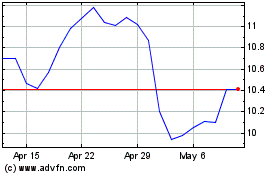New California Rules Restrict Power Plants' Marine Water Use
May 04 2010 - 10:27PM
Dow Jones News
California regulators adopted new rules Tuesday that will
require power plants to reduce their impact on aquatic wildlife at
a potential cost of hundreds of millions, or billions of
dollars.
The California regulations are the first in the U.S. to restrict
marine water use by existing power plants and comes one month after
regulators in New York denied a key water-quality permit that
Entergy Corp. (ETR) needs to continue operating a nuclear power
plant.
The rules, adopted by the California Water Resources Control
Board, require power plants that withdraw and return marine water
for cooling to stop the practice and install equipment to reduce
their impact on marine life. The regulations affect 19 power plants
that use ocean or river water to cool power turbines, then return
the water at higher temperatures in a practice called "once-through
cooling."
The policy aims to improve conditions for California marine
life, but is likely to add substantial costs to some power plant
owners that could reach into the hundreds of millions or billions
of dollars. Most plants will have to phase out their once-through
cooling systems within the next several years, although plant
managers can apply for alternatives that would reduce the cost. The
agency estimated the upgrades will cost about 1 cent a
kilowatt-hour, on average, not including lost revenue while plants
are taken offline during construction.
The plants' once-through cooling systems kill 2.6 million fish,
19 billion fish larvae and 57 seals, sea lions and sea turtles each
year, Dominic Gregorio, the water board's ocean unit chief, said
Tuesday before the board's vote.
Power-plant owner Dynegy Inc. (DYN) criticized the draft
regulations, saying they'll force the company to shut down at least
two of its plants. Dynegy will likely have to shut its aging South
Bay power plant near San Diego by 2013 and its Morro Bay power
plant by 2015, when the plants are required to be in compliance
with the new rules, a Dynegy representative told the board Tuesday.
Dynegy may also have to shut one unit of its Moss Landing power
plant, although the company will likely install new equipment at
the plant's second unit by 2016, when the plant must be in
compliance, he said.
Some of the other older power plants affected by the rules,
owned by AES Corp. (AES), PG&E Corp. (PCG) and Mirant Corp.
(MIR), are already slated to be shut down or renovated.
AES, of Arlington, Va., plans to replace its Alamitos and
Huntington Beach power plants in Southern California or retrofit
the plants with alternative cooling systems.
The state's two nuclear power plants, owned by PG&E and
Edison International's (EIX) Southern California Edison unit, will
have until 2024 and 2022, respectively, to reconfigure their
cooling systems to comply with the rules.
In the New York case, Entergy said replacing the once-through
cooling system at its 2,000-megawatt Indian Point plant with a
"closed-loop" cooling system, as recommended by New York
regulators, would cost about $1 billion and take 15 years to
complete. Instead, the company has proposed installing "wedge wire
screens" to protect fish, at an estimated cost of $100 million.
Charles Hoppin, chairman of the California water board, said he
and others on the board are concerned about the reliability of
California's grid and that the rules were crafted with help from
the state's energy regulators and grid operator to ensure that
plants could be retired or renovated on a schedule that would
ensure adequate power supplies are available.
-By Cassandra Sweet, Dow Jones Newswires; 415-439-6468;
cassandra.sweet@dowjones.com
Mirion Technologies (NYSE:MIR)
Historical Stock Chart
From Mar 2024 to Apr 2024

Mirion Technologies (NYSE:MIR)
Historical Stock Chart
From Apr 2023 to Apr 2024
